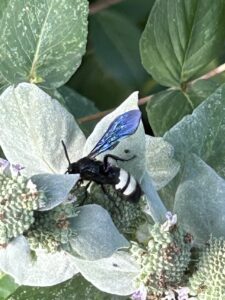
Recently, Nancy observed a striking bee-like creature feeding on our patch of aromatic Mountain Mint.
The black and white bee with purple wings is actually a wasp – a Mason Wasp. They are found in the Eastern part of the United States in mid- to late summer, a frequent visitor to nectar producing plants such as goldenrods, snakeroots, and mountain mint. The striped wasps are solitary creatures and build mud chambers where they stuff their kill – caterpillars, spiders, and the like. They also lay an egg in each chamber which pupates and later becomes an adult wasp.
Being a member of the wasp family, I expect it packs a powerful punch with its sting, but so far, we leave them alone and they leave us alone.
Once again, I’d like to heartily recommend the Short-Toothed Mountain Mint to fellow gardeners and conservationists because it is extremely effective in drawing pollinators. Honeybees literally flock to our two-foot-tall mints. Who knows how far they must travel to reach our yard, so the Mountain Mint must have quite a drawing power.
A hearty perennial, Mountain Mint is easy to grow, deer can’t stand it, it is drought and heat resistant and it attracts all kinds of pollinators – including the lovely Mason Wasps. Plant now and enjoy a back yard of bees next summer.

